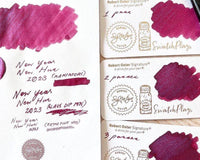Washi tape and masking tape are often used interchangeably. While they have many common characteristics and are used for similar purposes, there are distinct differences that make each unique. Here, we’ll explore the qualities of each type of tape and discuss where they are similar and different.
Are washi and masking tape the same?
Conceptually, washi and masking tape are the same. They are strips of material with an adhesive that are used for bonding or joining objects.
But exactly what is washi tape? The term “washi” comes from the words “Japanese paper.” Washi tape was originally sold as Japanese masking tape, then the manufacturers eventually added more designs and released more beautified tapes into the stationery market.
The difference between washi and masking tape

Although they serve similar purposes, there are notable differences between washi tape and masking tape.
Adhesive
Masking tape uses natural rubber adhesives that have medium to high tack. These tapes are very durable, with great temperature tolerance and resistance to solvents and UV rays. Acrylics are also sometimes used for masking tape adhesives.
Washi tape, on the other hand, has a low tack adhesive. It is pressure sensitive, which allows for easy removal without affecting surfaces. You can then reuse or reposition the tape anywhere. Washi tape also has weaker adhesion than masking tape, which may cause the latter to break paper when removed.
Material
Washi tape is created from traditional Japanese paper. The fibers of washi tape are usually created from plants such as bamboo, kozo (mulberry), rice, and mitsumata, and the paper is hand-processed before the adhesive is applied.
Masking tape, also known as painter’s tape, is made of crepe paper that is easy to tear by hand. Some masking tapes are also made of polymer film instead of thin paper.
Residue
Masking tapes usually leave a sticky residue on surfaces, especially if left on for a long time. This can chip off paint and other finishes. Washi tape does not leave any residue. It is simple to remove and doesn’t damage surfaces.
Longevity
Washi tapes can last a year or longer, especially when used in wall decorations and similar applications. Most masking tapes have a one-year shelf life and are made to stick to surfaces for a short time.
The Bottom Line

Masking tape and washi tape both have their uses. Generally, washi tape is used for decorative purposes, while masking tape is used for packing, repairs, and the like. Knowing the difference between the two can help you decide which tape suits your needs.
Written by EndlessPens Blogger Ramona Kabigting







